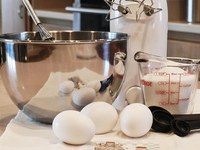Prairie Fare: Mix Up Some Quick Bread
(Click the image below to view a high-resolution image that can be downloaded)
By Julie Garden-Robinson, Food and Nutrition Specialist
NDSU Extension Service
“What kind of bread are you making this weekend?” my 16-year-old daughter asked.
My 11-year-old daughter and I have been treating the family to a different bread every week for many weeks. We’ve made buns, loaves of bread, naan (an Indian yeast bread) and others.
The 11-year-old and I pondered my older daughter’s question and looked at each other. I think we shrugged our shoulders in unison. We were tired after a long week of sixth grade for her and work for me.
I don’t think we had a multistep, all-afternoon project on our minds despite the presence of our eager taste-testers. I had an idea, though.
“I think we will make quick bread instead of yeast bread this week. In fact, we’ll make some ‘really quick’ bread,” I responded.
Yeast breads require multiple steps, while quick breads are mixed and baked immediately. They rise quickly because the leavening agent acts early in the baking process.
I had a little trick up my sleeve. Actually, my secret ingredient was in the cupboard.
We would be doing our weekly kitchen chemistry experiment, but we would be using a cake mix to speed the process.
Quick breads usually contain flour, a fat, a liquid, sugar, salt, vanilla and a leavening agent. Some quick bread recipes call for fruit, such as bananas or pumpkin, and/or spices for flavor. Eggs usually are needed to bind all the ingredients together.
Baking soda and baking powder are common leavening agents that cause the batter to rise and become light-textured breads. With the right combination and amounts of ingredients and the application of heat, carbon dioxide is released. Baking soda needs an acidic ingredient in the batter, such as sour milk or molasses.
Making quick bread requires quite a few ingredients to measure, and cups and measuring spoons to wash. Obviously my daughter and I were not “balls of energy” that morning. I grabbed a yellow cake mix from the cupboard, and my daughter began measuring spices into a mixing bowl.
Who invented cake mixes, anyway? I always enjoy learning about food history, so I did some looking for history about these time-saving mixes.
An article that appeared in Bon Appetit magazine detailed the history of the baking mix. Although many people think the cake mix appeared during World War II, the first baking mixes were patented in 1933 by John D. Duff.
The U.S. had a surplus of molasses, and gingerbread mixes became a way to use up this ingredient. The molasses was dried and mixed with flour, powdered eggs, sugar, spices, shortening and other ingredients. You simply needed to add liquid, mix and bake.
The early mixes became a way of helping families reduce the types of baking ingredients they needed to have on hand. While the first mixes used powdered eggs, the manufacturers later learned that homemakers preferred to add their own fresh eggs to the mix. When they cracked the eggs and added them to the bowl, the experience was more like “baking from scratch.”
A baking mix requiring the addition of eggs was patented later. Cake mixes became very popular in the 1940s, with more than 200 companies producing them.
As my daughter and I assembled our quick bread, we saw that using a cake mix eliminated the need to measure flour, salt and sugar. We did have several spices to measure, so my daughter really wasn’t off the hook in the measuring department.
The recipe we made was named “bread” but seemed more like dessert to me. I think this pumpkin bread would be delicious with a dollop of whipped topping and a sprinkle of cinnamon. Pureed pumpkin is high in fiber and an excellent source of beta carotene, which our bodies use to make vitamin A.
“Easy Peasy” Pumpkin Bread
1 package yellow cake mix
2 tsp. ground cinnamon
1/2 tsp. ground ginger
1/4 tsp. ground cloves
1/4 tsp. ground nutmeg
1 (15-ounce) can pure pumpkin (not pumpkin pie filling with spices already added)
1/3 c. canola or other oil
3 eggs
1 c. dried fruit such as cranberries or raisins (optional)
Preheat oven to 350 F. Grease bottom and sides of two 8 1/2- by 4 1/2-inch loaf pans, then lightly flour the pans. Mix cake mix and spices, then add pumpkin, oil and eggs and beat for two minutes. If desired, stir in dried fruit. Pour batter into pans and bake for 40 to 45 minutes, until a toothpick comes out clean. Cool for 10 minutes in the pan, then carefully remove and cool on a wire rack.
Makes two loaves, 16 slices per loaf. Each slice has 95 calories, 4 grams (g) fat, 14 g carbohydrate, 1 g protein and 110 milligrams sodium.
(Julie Garden-Robinson, Ph.D., R.D., L.R.D., is a North Dakota State University Extension Service food and nutrition specialist and professor in the Department of Health, Nutrition and Exercise Sciences.)
NDSU Agriculture Communication - Nov. 20, 2014
| Source: | Julie Garden-Robinson, (701) 231-7187, julie.garden-robinson@ndsu.edu |
|---|---|
| Editor: | Ellen Crawford, (701) 231-5391, ellen.crawford@ndsu.edu |


